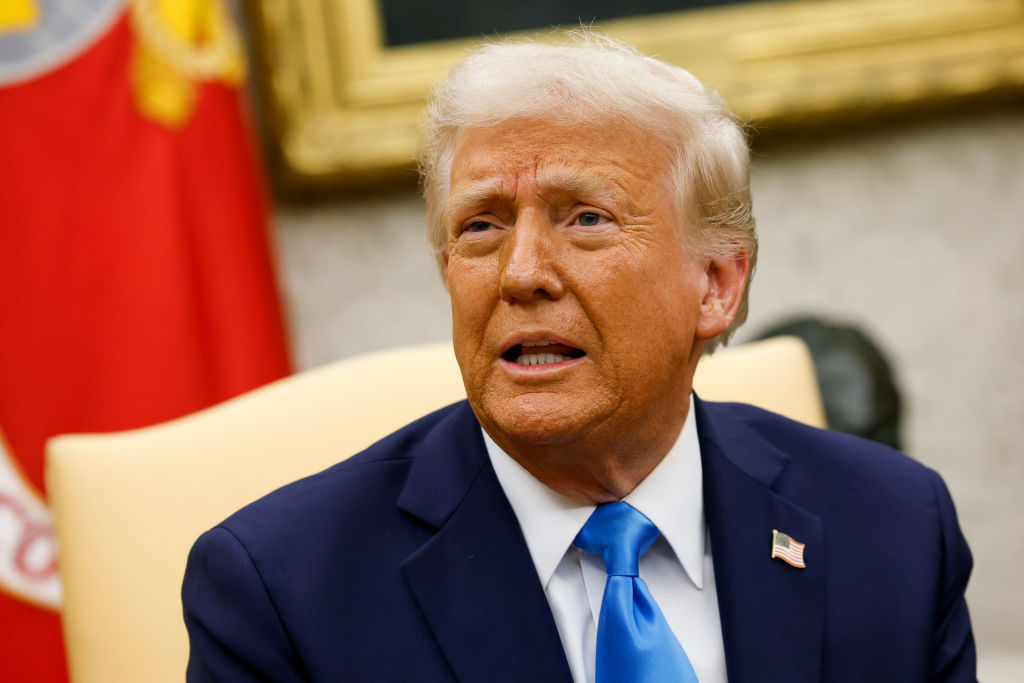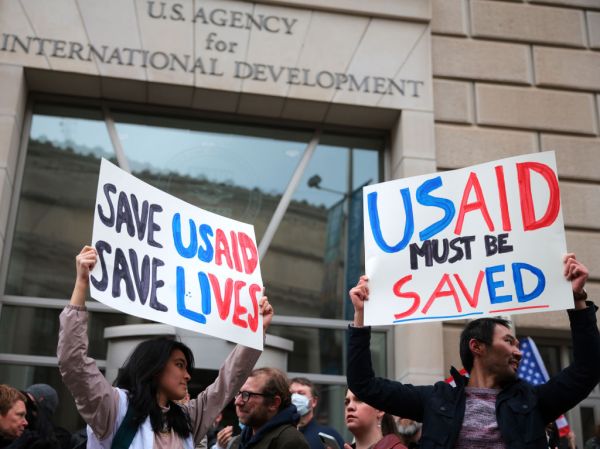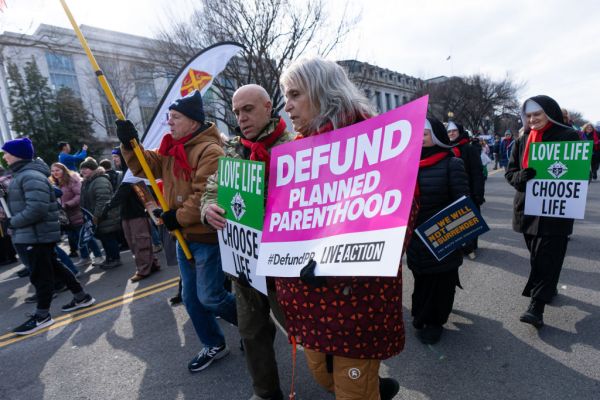Tens of millions of voters were driven to the polls in 2024 by anger over the economic damage wrought by the incumbent Democratic administration. While some degree of post-pandemic inflation was inevitable, President Joe Biden ignored economists’ warnings by flooding the economy with too much stimulus, runaway spending, bailouts, and red tape that pushed the inflation rate to 9 percent. Yet Donald Trump—while harshly condemning Bidenomics—is set to repeat Biden’s mistakes by dismissing economists’ warnings against his own reckless proposals to dramatically expand budget deficits, endanger economic growth, and unleash inflation.
Many Republicans who spent the past four years highlighting every negative aspect of the Biden economy will quickly shift to highlighting every positive aspect of the Trump economy. Indeed, Trump boosters will likely declare victory if the economy maintains the healthy growth, soaring stock market, and low unemployment of the past few years. The Trump administration inherited the Biden economy’s worst failures as well—inflation, rising interest rates, and threats to long-term economic growth. Unfortunately, Trump’s policies threaten to worsen rather than improve these economic conditions.
Major economic challenges.
Start with inflation. While the inflation rate has notably fallen from the mid-2022 peak of 9.1 percent, it steadily rebounded upward in the second half of 2024 to an annualized monthly rate of roughly 4 percent—well above the Federal Reserve’s target rate of 2 percent. Yet despite campaign promises not only to reduce inflation but to reduce prices—that is, to achieve deflation—Trump’s economic policy agenda is aggressively inflationary. The purpose of Trump’s proposed tariffs—leaving aside the deals he just made with Canada and Mexico—would be to raise import prices so high that American consumers switch to domestic alternatives that they’d previously rejected as too expensive. However, not only can certain foreign imports not be substituted for American goods, but even American-produced goods will likely see higher prices due to the cost of tariffs on their foreign inputs, as well as a lack of foreign competition to hold down prices.
In addition to tariffs, Trump’s deportation agenda—whatever merits it may have—is sure to raise prices by creating a worker shortage in immigrant-heavy industries such as agriculture, construction, health care, hospitality, and landscaping. The resulting worker shortages followed by an eventual shift to non-immigrant workers will raise business costs that will be passed on to consumers. Furthermore, Trump’s promise to lavish families with trillions of dollars in new tax cuts and spending expansions risks repeating Biden’s inflationary acceleration with the 2021 American Rescue Plan. Beyond that, Trump’s threats to Federal Reserve independence—whether based on institutional reforms or merely political pressure—may reduce the Fed’s aggressiveness in slamming the brakes on inflation. Add it up, and the inflationary arrows likely point upward under President Trump.
Higher inflation would accelerate the rise in interest rates. The yield on the 10-year Treasury bond has jumped from 3.6 percent to 4.6 percent between September and Inauguration Day, and even the rate on 12-month Treasuries exceeds 4 percent. These escalated interest rates have persisted even as the Federal Reserve reduced the federal funds rate three times in late 2024. Consequently, mortgage rates have climbed from 6 to 7 percent since September on top of housing prices that have already leaped by 30 percent since the COVID-19 pandemic. In total, the monthly mortgage payment on a newly purchased median-priced home has doubled since 2021. Trump’s aforementioned inflationary agenda—as well as the bond market’s response to swelling deficits—threaten to further push up rates and choke the economy.
The most pressing long-term risk is sluggish economic growth. Trump and his appointees have promised to push economic growth rates to 3 percent or even higher, which they claim will provide enough tax revenues to pay for trillions in new tax cuts. The challenge is that the 2017-2019 heyday of strong growth, low inflation, and rising wages averaged 2.7 percent annual economic growth, and even that was goosed with tax cuts and bloated discretionary spending increases. Rapid economic growth is regularly promised and rarely delivered, even after the enactment of supposedly pro-growth policies.
“The Trump administration inherited the Biden economy’s worst failures as well—inflation, rising interest rates, and threats to long-term economic growth. Unfortunately, Trump’s policies threaten to worsen rather than improve these economic conditions.”
In fact, just maintaining growth in the 2 to 2.5 percent range will prove challenging. Long-term economic growth comes from growing both the labor supply (more workers) and productivity (more output per worker hour). If the labor force expands by 2 percent, and all workers become 2 percent more productive, then the total value of goods and services produced (the GDP) will expand by a little more than 4 percent. Historically, faster economic growth has often resulted from rapid labor supply growth, such as the baby boomers or more women entering the labor force. Yet the Congressional Budget Office (CBO) projects the U.S. population to nudge upward from 350 million to 364 million over the next decade—and then roughly level off for the rest of the century. In fact, CBO projects that within a decade the number of annual deaths will begin exceeding annual births—with only immigration preventing a dramatic population decline. America’s workforce will be held back by the retirement of the baby boomers, low fertility rates, and insufficient immigration to plug the gap. Adding Trump’s proposed border restrictions and mass deportations will thus likely bring stagnant or declining population growth.
Reducing labor supply growth to zero will mean that productivity growth would have to rise dramatically just to maintain the current economic growth rates. Sustained growth of 3 percent or higher would require nearly doubling productivity growth rates. And yes, it is well premature to bet the future of the U.S. economy on the hope that AI will produce a historic productivity surge. After all, the 1990s information technology revolution largely ran its productivity course in a little over a decade without fundamentally altering permanent economic growth rates.
President Trump (and his successors) may find that, without immigration or an aggressive baby boom, an aging America will face sluggish economic growth, economic dislocations, and huge unfunded liabilities for Social Security and Medicare. If such a future sounds far-fetched, look at the past three decades in Japan.
Of course, the most predictable MAGA response to these economic policy warnings is to dismiss the entire economics profession as a bunch of out-of-touch eggheads who are wrong about everything. That’s essentially what President Biden did shortly after taking office when economists across the spectrum warned him that shooting a $1.9 trillion American Rescue Plan into a supply-constrained economy would drive pent-up inflation even higher. Biden ignored the experts, Congress passed the bill, and Biden saw his presidency collapse under the weight of 9 percent inflation. While economists have certainly been wrong too many times to count, any skepticism should be driven by a competing economic framework that is coherent and empirically grounded—rather than just pandering to lazy political populism and pretending that even the most obvious economic consequences do not exist. The laws of economics eventually always win, and ignoring them has destroyed many presidential legacies.
Shattering records for federal debt.
Soaring federal debt remains the most serious long-term threat to American prosperity. In 2017, Trump took office with a budget deficit of $585 billion and proceeded to aggressively cut taxes and expand spending. In 2025, Trump reenters the White House with a budget deficit of $1.8 trillion—and has again promised to aggressively cut taxes and expand spending on defense and border security. Simply extending current policies would push the annual deficit to $3.6 trillion within a decade. The debt held by the public would surge to a record of 135 percent of GDP, which is triple the typical 1960-2008 level. Within three decades, the projected federal debt (under current policies) exceeds 235 percent of GDP—or approaches 300 percent of GDP if interest rates rise.
The resulting interest costs will bury the United States. Since 2021, annual interest costs have already jumped from $352 billion to $881 billion and are projected to exceed $2 trillion annually within a decade under current policies. Annual interest costs have recently surpassed Medicaid and defense, and are set to exceed Medicare this year and Social Security within two decades to become the largest federal expenditure. A decade from now, interest will likely consume 27 percent of federal revenues, or all federal taxes paid from January 1 through April 8.
And the CBO figures assume Washington pays a 3.5 percent interest rate on its debt over the next decade—even as the 10-year Treasury bond that often mirrors the average federal interest rate currently trades at 4.6 percent. Within the next year, one-third of all marketable U.S. Treasury securities will roll over into new interest rates that will also be applied to $30 trillion in additional projected 10-year deficits. If interest rates remain around 4.5 percent instead of the projected 3.5 percent, that will add another $500 billion to annual deficits by 2035. Budget deficits exceeding $4 trillion are possible within a decade.
“The laws of economics eventually always win, and ignoring them has destroyed many presidential legacies.”
A responsible president facing these challenges would pursue an aggressive deficit reduction strategy to rein in borrowing and reassure the bond market (thus lowering interest rates). Instead, Trump has demanded trillions in new tax cuts, pandering to voters with promises to end taxes on tips, overtime, and Social Security benefits, in addition to extending and possibly expanding his 2017 tax cuts. Trump is also widely expected to push for significant defense and border spending expansions, while pledging to do nothing to rein in $124 trillion in projected 30-year shortfalls for Social Security and Medicare.
There is no mathematical path to make these promises fiscally responsible, no easy trillion-dollar deficit-reducer that had been forgotten or hidden. Economic growth is no panacea. Treasury Secretary Scott Bessent’s target of sustained 3 percent economic growth rates faces the aforementioned barrier of a stagnant (or even declining) workforce, not to mention the lack of a blueprint to achieve such faster growth. And even if 3 percent growth was achieved, most of the tax revenues may be consumed by the higher interest rates on the federal debt that often follow strong economic growth. Lawmakers should aspire to rosy economic scenarios while budgeting for a more typical economic performance.
Trump has promised trillions of dollars in tariff revenue. However, CBO estimates that even a 10 percent universal tariff with a 60 percent Chinese tariff would raise perhaps $300 billion annually, which will not even pay for Trump’s new promises, much less address the baseline deficit. Moreover, retaliation from U.S. trading partners would accelerate economic losses that reduce federal tax revenues, and most remaining tariff revenues may be reprogrammed into bailouts for those industries hit with retaliatory tariffs (as occurred in Trump’s last administration). For all their economic costs, tariffs are unlikely to significantly reduce deficits.
Nor is the Department of Government Efficiency (DOGE) likely to reverse the debt surge. Trump has already taken Social Security and Medicare savings off the table, and even Republican Congresses rarely agree to significantly cut existing programs. Despite President Trump’s executive order establishing DOGE narrowed its focus to “modernizing Federal technology and software to maximize governmental efficiency and productivity.” Yet DOGE director Elon Musk has taken the lead on attempting to illegally impound $40 billion of funding for the U.S. Agency for International Development (USAID) while cancelling other federal contracts and offering federal employees a buyout. A prolonged impoundment would likely be blocked by the courts, and the administrative savings from paring back federal employment and government contracts would not even reach 1 percent of federal spending. Despite a longing for easy shortcuts, addressing deficits still requires tougher decisions on Social Security, Medicare, defense, and taxes.
Overall, the first rule of holes is to stop digging. Trump should scale back and offset his tax-cut agenda with spending cuts, and any expansions to defense and border spending should also be offset elsewhere. From there, Republicans and Democrats should freeze discretionary spending, look for savings in routine spending, and—most importantly—begin working together toward an everything-on-the-table deficit solution that includes savings from Social Security, Medicare, and taxes. History shows that sharply partisan pushes to slash popular spending programs (especially to pay for tax cuts) almost never pass Congress. And gimmicky solutions like a balanced budget amendment, “Penny Plan,” and empty promises of aggressive deficit reduction are meaningless without a realistic, detailed, and specific set of spending and tax reforms to meet those targets. It’s better to propose modest savings reforms and enact them than to once again make outlandish promises to balance the budget within a decade and then enact nothing.
Yes, these recommendations for aggressive, bipartisan deficit reduction appear completely out of touch with how Washington operates today. Which explains how we got into this mess. For all of the voter complaints about budget deficits, surveys show overwhelming support for expanding most spending programs and fierce opposition to paying notably higher taxes (although most voters are happy to dump such a burden on others by taxing millionaires or cutting foreign aid). Politicians are rewarded for grandstanding about deficits, and punished for working across the aisle on bipartisan solutions. Trump and nearly all of today’s federal lawmakers have served only in an era where popularity is bought with Santa Claus-style tax cuts and government benefit expansions. They cannot relate to the 1985-2000 era of deficit reduction, when new policy proposals were expected to be paid for, deficit reduction was a priority, and lawmakers had to find non-Santa Claus approaches to winning over their constituents.
But circumstances might force them into action. Trillion-dollar government handouts are more likely to bring inflation than reelection. The bond market is already demanding higher interest rates on U.S. Treasuries even as the Federal Reserve cuts the federal funds rate. Social Security and Medicare’s annual cash shortfalls are heading toward $2 trillion, and galloping interest costs risk burying the federal budget. President Trump cut taxes and hiked spending by $8 trillion over the decade in his first term. Repeating such fiscal recklessness on top of today’s deeper deficits would be nothing short of economic and fiscal malpractice. Rather than truly reducing the tax burden, Trump’s policies would merely defer it with interest. Trump is inheriting a much more perilous economy and fiscal outlook in 2025 than in 2017. It remains to be seen if he will learn from Biden’s failures by prioritizing economic prosperity, low inflation, and deficit reduction over populist pandering.









Please note that we at The Dispatch hold ourselves, our work, and our commenters to a higher standard than other places on the internet. We welcome comments that foster genuine debate or discussion—including comments critical of us or our work—but responses that include ad hominem attacks on fellow Dispatch members or are intended to stoke fear and anger may be moderated.
With your membership, you only have the ability to comment on The Morning Dispatch articles. Consider upgrading to join the conversation everywhere.